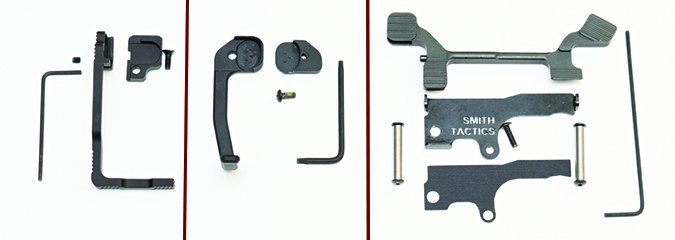
When it comes to ambidextrous capabilities, the AR platform still lags behind the modern semi-automatic pistol. How would ambidextrous controls make the AR-15/AR-10 more desirable? One easy answer is to accommodate the left-handed shooter. Another reason would be to help keep the weapon in the fight should the operator be left with only one available hand. Ambidextrous thumb safeties are somewhat popular, and so are magazine releases, but to a lesser extent. The focus of this evaluation is to compare three different aftermarket products that offer a secondary method for releasing the bolt of the AR-15 or AR-10 rifle. They are the $30 Magpul BAD Lever, the $29 Troy Ambidextrous Bolt Release Lever, and the $80 BattleBar from Smith Tactics. Neither the Magpul or the Troy Industries units required disassembly beyond separating the upper and lower ends of the rifle. The BattleBar required replacement of the hammer and trigger pins with supplied components. All three units were made from aluminum.
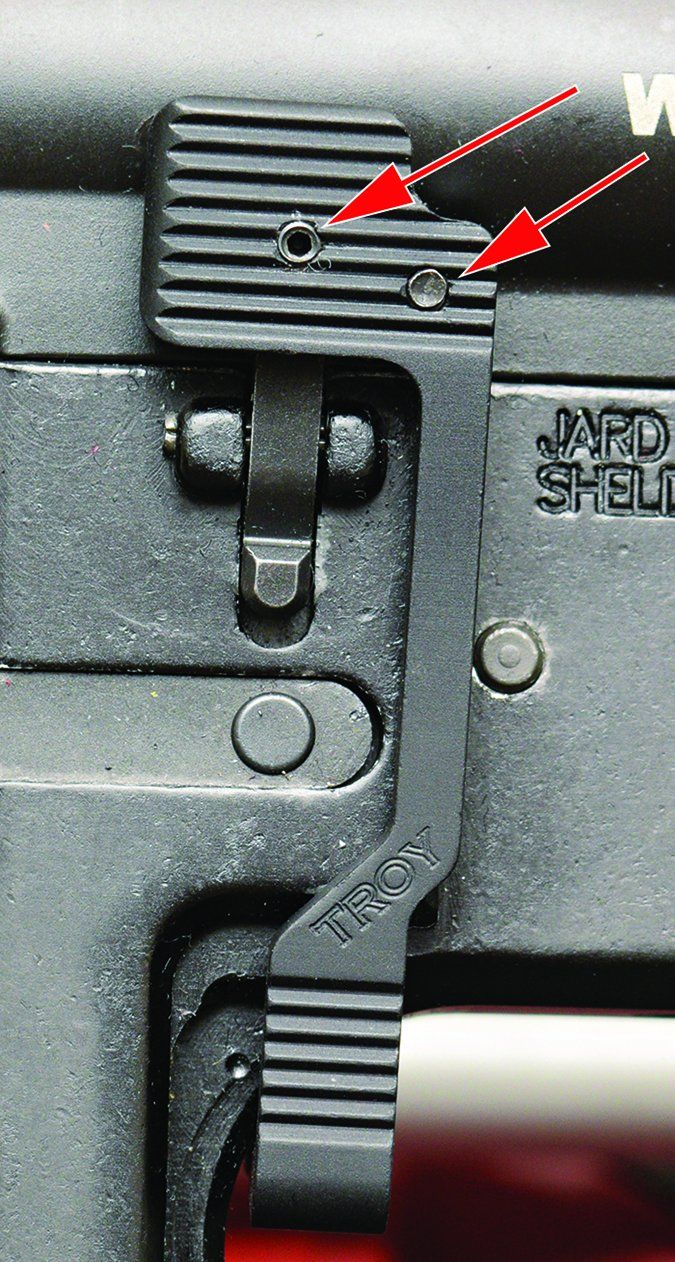
Protocol for loading the AR-15 begins with pushing the magazine upward into the magazine well until it clicks then tugging on the magazine to make sure it is seated. Next, the bolt release is pressed to bring the gun into battery. Mounted on the left-hand side of the receiver directly above the magazine well, the release is the upper portion of the combination bolt-lock and release lever that pivots with a seesaw motion on a centralized roll pin. Throughout this entire process, the strong hand remains in place, supporting the rifle and maintaining access to the trigger and thumb safety.
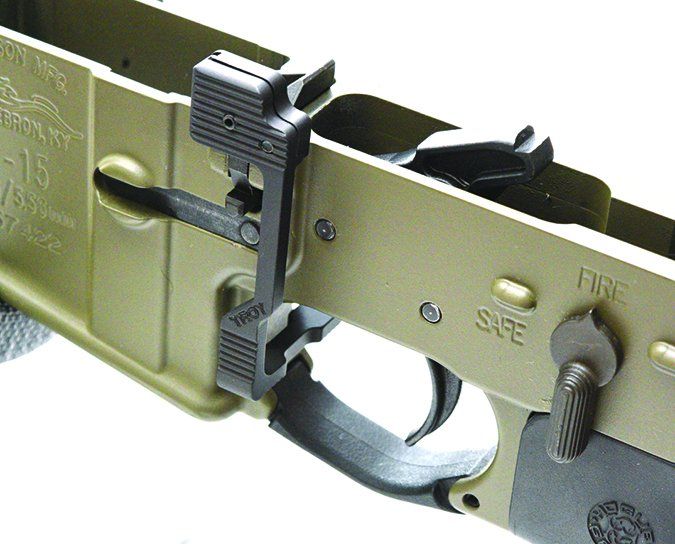
By adding any one of our test products, the operator can save some time by moving the hand directly to the support position after seating the magazine. This may seem like a minor consideration, but experienced AR operators point to instances wherein the support hand is needed to push open a door or the shooter needs to fire immediately after completing a reload. Also, participants in High Power Service Rifle competition can use this feature when top-loading single rounds is mandatory. Placing a round into the chamber and closing the bolt with the strong hand is a lot easier than untangling a gloved support hand from a sling. For tests, all three components were mounted on multiple rifles to check fit and function. Let’s see how efficiently the three bolt-release levers operated.
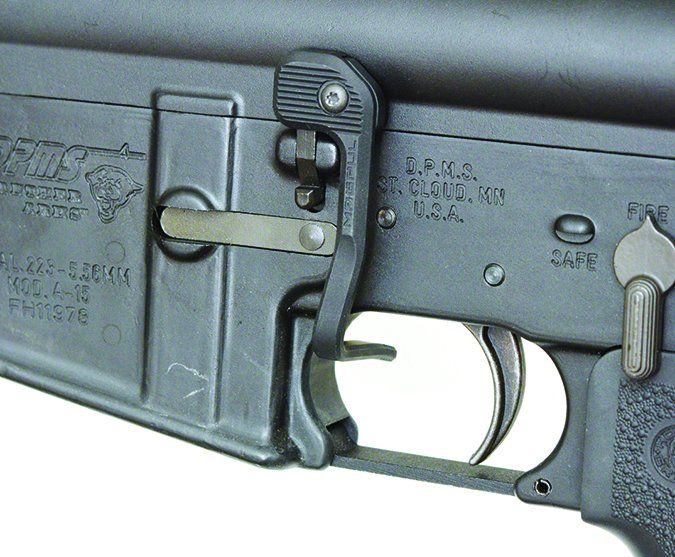
Magpul Industries BAD Lever, $30
GUN TESTS GRADE: A-
The Magpul BAD lever was an L-shaped device that clamped over the bolt-release pad in what could be referred to as a “clam shell” pattern. One Torx-head screw was used to secure the unit. The lever ran down along the left side of the receiver and poked through the trigger guard to the right-hand side. A slight angle was added to keep the lever tucked in against the forward most arc of the trigger guard. The operator could release the bolt by pushing from right to left or by pushing downward on the paddle. Either way, operation was crisp and sure. We did notice that once the bolt was released, the contact point rode lower inside the trigger guard.
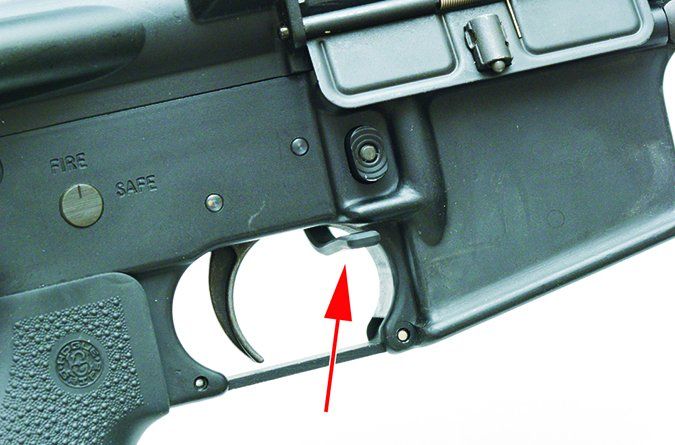
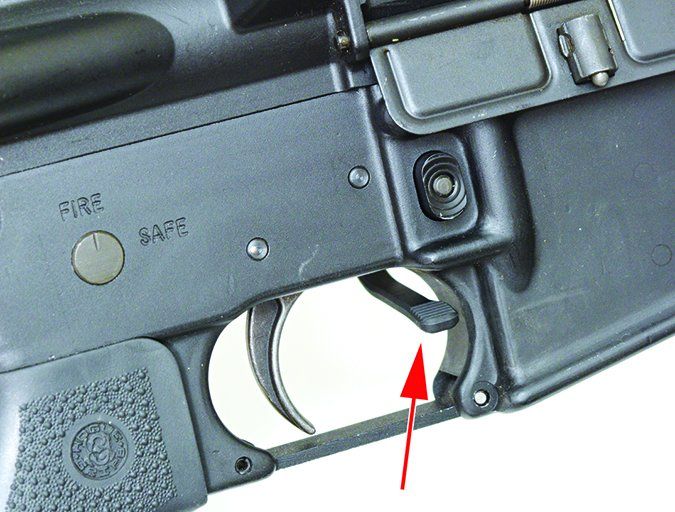
Our Team Said: The single attachment screw was robust and did a good job of keeping the BAD Lever attached. A small amount of blue LocTite was visible in the threads of the screw, and we would recommend making sure it stayed in place. We liked the way the lever hugged the upper interior of the trigger guard when the bolt was back. We were not so pleased because, when the bolt was in battery, the BAD Lever took up additional space. The BAD Lever was otherwise foolproof.
Troy Industries Ambidextrous Bolt Release, $29
GUN TESTS GRADE: A
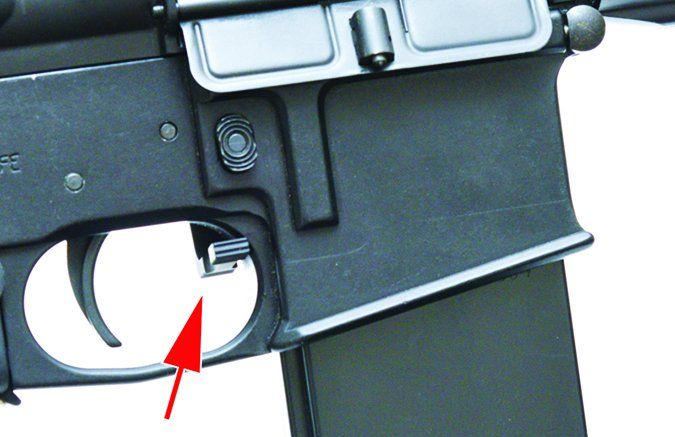
Like the Magpul BAD lever, the Troy Industries Ambidextrous Bolt Release mounts via a clamshell covering the release lever. The Troy’s extension drops down just a little lower than does the BAD and makes a 90-degree turn to bring its control pad to the right-hand side of the receiver. The Troy lever prefers to be pushed crossways from right to left rather than pressed downward. The Troy unit was a little heavier-made than the Magpul unit and utilized a flat-head screw as well as a small Allen screw to lock it into place. Nevertheless, there was a small amount of play as the unit could be rotated forward and back even when tightened down. But there was an extra groove where the two parts meshed to surround the release paddle that helped keep the unit attached. We proved this by not securing the screws with LocTite. After about 500 rounds, the lever was loose and freely rotating on the release paddle. But it never came off the gun. We used LocTite and torqued down the screws. About 800 rounds later, it’s still holding strong. If the control point of the Troy unit is ever so slightly larger, it did not change its position inside the trigger guard whether the bolt was locked back or in battery.
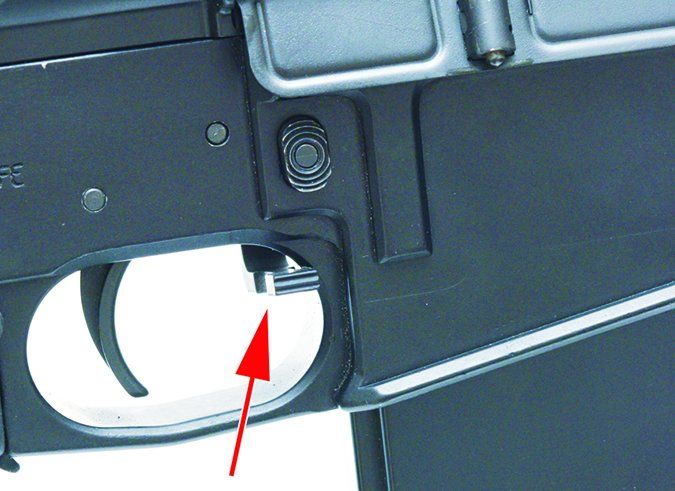
Our Team Said: We had hesitated to use LocTite at first because the flat-head screw offered a shallow slot that we would probably strip if we had to remove it or tighten further if the adhesive were in place. But the only way to securely mount the Troy was to use plenty of LocTite, even if there was still a little bit of play. In use we like the way the lever returned to the same position. Overall it seemed more substantial than the BAD Lever. Ultimately we were split on choosing the BAD over the Troy. They both proved effective when properly attached. The decision to mount either of these components might rely more on your willingness to give up space inside the trigger guard rather than on which unit was better than the other.
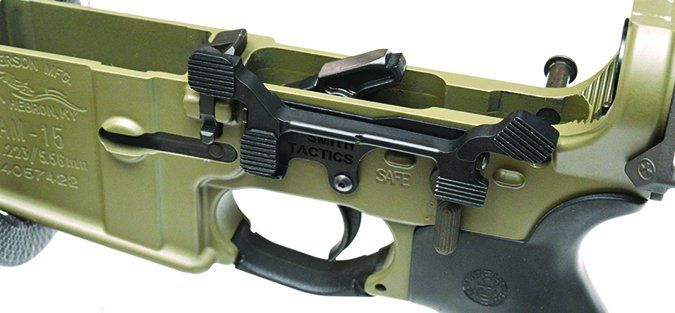
Smith Tactics BattleBar, $80
GUN TESTS GRADE: C
The BattleBar from Smith Tactics does not make the AR-15 ambidextrous per se, but was designed to allow the operator to close the bolt without using the left hand or removing the strong hand from the grip. Instead of providing right-side access to the bolt release via a crossing lever, the BattleBar essentially moves the release paddle from it actual position to a point directly above the thumb safety.
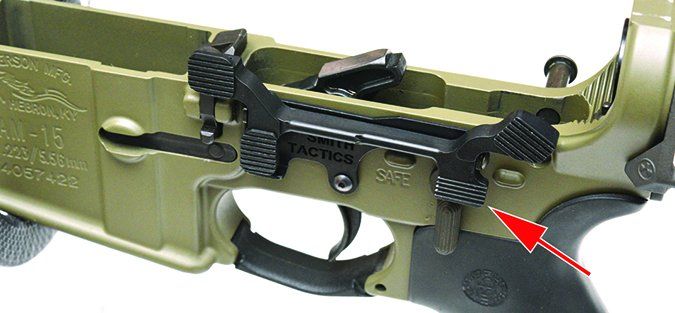
The BattleBar mounts to the left-hand side by first applying a bracket to the receiver that is held in place by the hammer pin and the trigger pin. Threaded locking pins are supplied to replace the standard pins, the caps of which are Allen screws that serve to hold the bracket in place. A gasket was supplied to provide a backing between the bracket and the receiver body. The BattleBar itself consisted of a paddle that fits over the original release paddle on the forward end and is connected to a plate that extends parallel to the receiver with a matching release paddle on the rearward end. There’s a roll pin that slips into a fitting at the forward end of the bracket. The rearward end of the BattleBar is seated inside the fitting at the opposite end by inserting an Allen screw, thereby creating an axle on which the unit rotates. As with each of our alternative bolt-release units, the original lever remains operational. The BattleBar the thumb safety was still accessible (and functional), but the selector arrow was partially obscured.
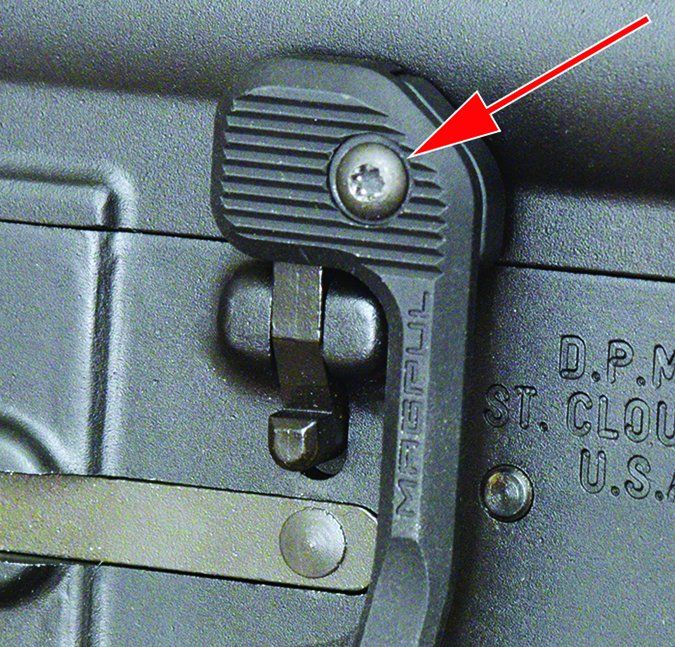
Installation was no more difficult than replacing the trigger and hammer pins. We tried the BattleBar on MilSpec rifles from DPMS, Palmetto State Armory, Anderson Arms, and Noveske. The BattleBar worked on each one, but the amount of force needed to press the paddle and release the bolt was heavier than we would have liked. We also thought the edges of the paddle were unnecessarily sharp, leading to discomfort. The contact point offering the most leverage was at its rearmost edge, causing us to open our shooting grip substantially. Gripping the handguard to help get more pressure on the bolt release took away the advantage of one-handed operation. In terms of mounting, we found a slight gap, about a sixteenth of an inch, between the BattleBar and the receiver on each rifle. We found that the smaller the gap, the less effort was required to release the bolt. To see if our BattleBar was out of spec, we ordered a second unit from Brownells.com. This second unit mounted closer to the receiver and seemed to rotate more freely. Nevertheless, the amount of force necessary to release the bolt was just as excessive and the results were the same.
Our Team Said: The BattleBar did offer a secondary method of releasing the bolt, but the amount of effort was excessive. To compensate, the operator was forced to change the strong-hand grip to the point where any advantage of single-hand operation and a quick return to fire was lost.
Written and photographed by Roger Eckstine.




























The heads those tiny set screws will most definitely strip out during removal efforts after blue Loctite. I ALWAYS have a heat gun handy. In an emergency, you heat the area with a lighter. Loosen while still hot. No problem. But you MUST use some sort of heat.